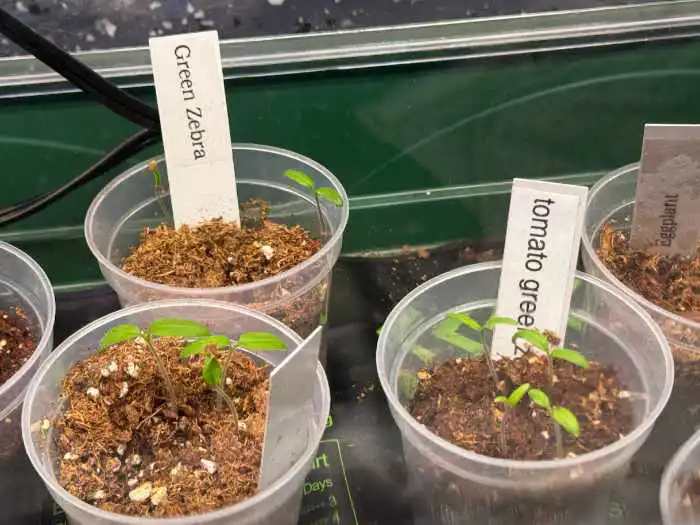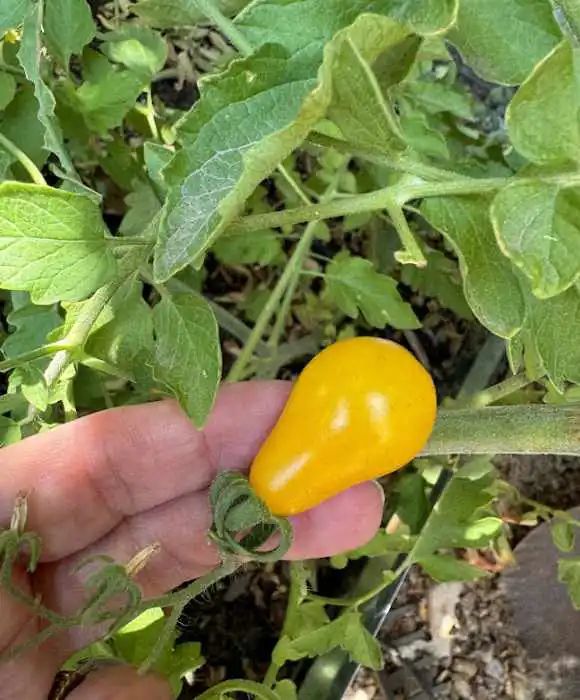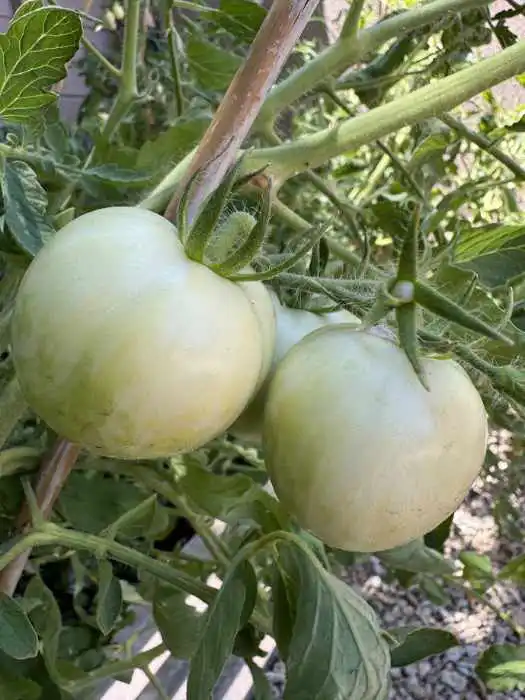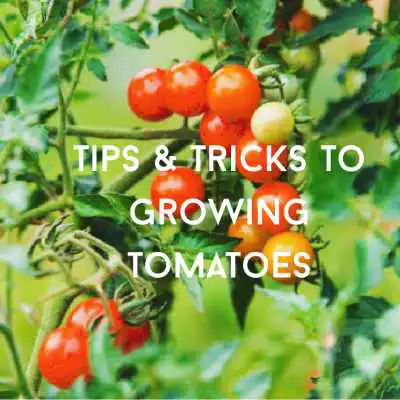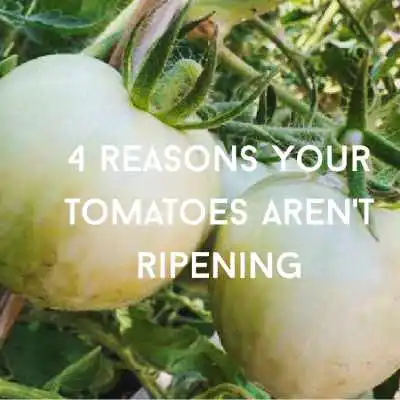Heirloom tomatoes are like the vintage treasures of the gardening world. These tomato seed varieties have been passed down through generations, for at least 50 years.
This post may contain affiliate links. Please read our disclosure policies.
What are Heirloom Tomatoes?
Unlike the more common hybrid tomatoes you find in supermarkets, heirlooms are open-pollinated, which means they can reproduce seeds that will grow true to type.
This gives you the same delicious and unique tomato year after year. The fruit is usually sweeter and more flavorful. Heirloom tomatoes tend to have less seeds.
Why choose Heirlooms?
The number one reason to choose heirloom tomatoes is for their flavor. We also love them for their unique colors and shapes. They come in a rainbow of colors, shapes, and sizes, each with its own distinct flavor profile. From the deep, rich taste of Black Krim to the sweet, fruity notes of Yellow Pear, there’s an heirloom tomato to satisfy every palate.
Are Heirloom Tomatoes Determinate or Indeterminate?
Most heirloom tomatoes are indeterminate. To learn more about Indeterminate and determinate tomatoes check out the post.
Are Heirloom Tomatoes Harder to Grow?
Tomatoes are a little tricky to grow in Phoenix. Most heirloom tomatoes are indeterminate, so they take longer to produce fruit. This makes them a little more challenging if you have a short season, like we do in Phoenix.
The Secret to Growing Tomatoes in Arizona
The solution is to purchase transplants or start from seeds indoors so they have a head start when you plant them outside.
Tomatoes can be transplanted outside mid-February in Phoenix. If starting from seed, start planting inside in December.
Heirloom Tomato Challenges
Heirlooms can be a bit more susceptible to pests and diseases due to their lack of genetic modification. Regular care and organic practices can help keep your plants healthy.
Many heirloom varieties are indeterminate and will need staking or caging to support their growth and keep the fruit off the ground.
Heirloom tomatoes are softer and more delicate than their hybrid counterparts, so they are more likely to be bruised when shipped.
Heirloom tomatoes can be a bit more finicky than hybrids, but don’t let that scare you off. Companion planting is one way to repel pests and enhance the growth of your heirloom tomatoes.
- Mulch around your plants to retain moisture and reduce weeds.
- Prune the lower leaves to improve air circulation and reduce the risk of disease.
- Plant basil, marigold, or nasturtium nearby to repel pests and enhance growth.
When to Plant Heirloom Tomatoes
Plant tomatoes outdoors after the last spring frost. As a general rule, if you’re growing heirloom tomatoes by seed in:
- Phoenix or Tucson: Sow seed indoors around mid-December. You can sow seeds indoors again mid-July.
- Flagstaff: Sow indoors around mid-April.
- Sedona or Prescott: Sow indoors around mid-February or March.
Best Heirloom Tomato Varieties to Grow
With so many heirloom varieties out there, it can be hard to choose which ones to grow. Below are a few favorites, especially suited for warmer gardening zones like gardening zone 9:
- Brandywine
- Black Prince
- Black Krim
- Cherokee Purple
- Mortgage Lifter
- Mr. Stripey
- Pineapple Tomato
- Green Zebra
- Tigerella
- Yellow Pear
- Amish Paste
Beefsteak Heirloom Tomatoes
Beefsteak tomatoes are one of the largest varieties of tomatoes, some with fruit reaching over a pound. They are great slicing tomatoes. Beefsteak heirloom varieties include:
Brandywine
Known for its incredible flavor, Brandywine tomatoes are large, juicy, and perfect for slicing. You can choose from several including pink, yellow and red.
- Gardening zones: 3-10
- Days to Maturity: 60-90 days
- Plant : 18-36 inches apart
- Type: Indeterminate
Black Prince
- Gardening Zones: 3-11
- Days to Maturity: 80 days
- Plant: 18-36 inches apart
- Type: Indeterminate
Black Krim
A popular variety. With a deep, rich flavor and dark, almost black skin, Black Krim tomatoes are a real treat.
- Gardening Zones: 3-10
- Days to Maturity: 80 days
- Plant: 18-36 inches apart
- Type: Indeterminate
- Temp: 75- 95 degrees
- Size: Medium fruit. 36-40″ tall
Cherokee Purple
These tomatoes have a rich, smoky flavor and a beautiful dusky purple color. These have been very popular at gardening sales.
- Gardening Zones: 3-10
- Days to Maturity: 60-90 days
- Plant 18-36 inches apart
- Type: Indeterminate
- Slicing Tomato
Mortgage Lifter
- Gardening Zones:3-10
- Days to Maturity: 60-90 days
- Plant 18-36 inches apart
- Type: Indeterminate
Mr. Stripey
- Gardening Zones: 3-10
- Days to Maturity: 80-90 days
- Plant 18-36 inches apart
- Type: Indeterminate
- Size: Large
Pineapple Tomato
- Gardening Zones: 3-10
- Days to Maturity: 60-90 days
- Plant 18-36 inches apart
- Type: Indeterminate
- Size: Large fruit – up to 2pounds
Cherry Heirloom Tomatoes
Yellow Pear
These small, sweet tomatoes are perfect for salads and snacking.
- Gardening Zones: 3-10
- Days to Maturity: 70-80 days
- Plant 18-36 inches apart
- Type: Indeterminate
Green Zebra
If you want something a bit different, try Green Zebra, Lycopersicon esculentum, tomatoes. They have a tangy flavor and striking green and yellow stripes.
- Gardening Zones: 3-10
- Days to Maturity: 60-90 days
- Plant 18-36 inches apart
- Type: Indeterminate
Tigerella
Great for salads these striking tomatoes
- Gardening Zones:
- Days to Maturity: 55-75 days
- Plant 18-36 inches apart
- Type: Indeterminate
- Size:2-3″ fruit
Amish Paste
As the name implies, Amish paste tomatoes are great for canning and for making sauce and paste.
- Gardening Zones: 3-10
- Days to Maturity: 80 days
- Plant 18-36 inches apart
- Type: Indeterminate
Are Heirloom Tomatoes Ugly?
The term “ugly tomato” refers to tomatoes that don’t fit the picture-perfect, uniform look you would typically see at the supermarket. Personally I find their unique shapes prettier than the uniform tomatoes.
These tomatoes might be oddly shaped, have bumps, scars, or even cracks. While they might not win a beauty contest, these imperfections often indicate a natural, unaltered growing process. Heirloom tomatoes are more fragile and can have imperfections.
Heirloom tomatoes can come in all sorts of shapes—some are round, others are more oblong, and some might even look a bit lumpy. This irregularity is part of their charm.
They come in a stunning array of colors, from deep purples and rich reds to bright yellows and vibrant greens. This diversity can sometimes mean unusual patterns or uneven ripening, which might be seen as imperfections.
Heirloom tomatoes often have thinner skins compared to hybrids, making them more prone to cracking and blemishes.
